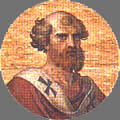 Following Innocent's death, Rome enjoyed the first peaceful papal election for
years. While the barons kept their swords sheathed, the cardinals unanimously
elected Guido de Castellis, the cardinal-priest of St. Mark. He took the name
Celestine II. Guido was born either at Citta de Castellis on the Tiber or
Macerata in the March of Ancona. Authorities differ as to his birthplace, but it
is certain that he was a man of excellent character. He had studied under Peter
Abelard and greatly admired this powerful thinker and brilliant lecturer.
Indeed, the outspoken St. Bernard, who regarded Abelard with high suspicion,
warned Guido, then a cardinal, not to carry his love for his old teacher to the
point of loving his errors. Learned and hard-working, Guido rose in the ranks of
the Church. He served in the papal court and was created cardinal by Honorius II
in 1127.
Following Innocent's death, Rome enjoyed the first peaceful papal election for
years. While the barons kept their swords sheathed, the cardinals unanimously
elected Guido de Castellis, the cardinal-priest of St. Mark. He took the name
Celestine II. Guido was born either at Citta de Castellis on the Tiber or
Macerata in the March of Ancona. Authorities differ as to his birthplace, but it
is certain that he was a man of excellent character. He had studied under Peter
Abelard and greatly admired this powerful thinker and brilliant lecturer.
Indeed, the outspoken St. Bernard, who regarded Abelard with high suspicion,
warned Guido, then a cardinal, not to carry his love for his old teacher to the
point of loving his errors. Learned and hard-working, Guido rose in the ranks of
the Church. He served in the papal court and was created cardinal by Honorius II
in 1127.
In the stormy times when Innocent II was opposed by Pierleone or Anacletus II,
Guido from the first stood by Innocent. Innocent raised him to the rank of
cardinal-Priest of St. Mark. Celestine's election was hailed with high
satisfaction. Great hopes were entertained, but Celestine, quite an old man, was
soon to die. His one achievement was the reconciliation of King Louis VII. This
settled a painful problem left over from Innocent's reign. Louis had forbidden
the canons of Bourges to elect Pierre de la Chatre archbishop, but the chapter
defied the king and elected Pierre. Louis thereupon determined that though the
canons might elect Pierre, he would see to it that the new archbishop never sat
on his episcopal throne. Pierre appealed to Pope Innocent against this
highhanded interference, and the Pope bluntly stated that Louis was but a boy
and must be educated. He personally consecrated Pierre archbishop, and when the
king still refused to let him into Bourges, Innocent put an interdict on every
place the king might enter. This meant that such places could have only the most
necessary church services and these performed without solemnity.
The count of Champagne, one of France's great feudal lords, gave the exiled
archbishop asylum. There was bad blood between king and count, and soon, despite
the efforts of St. Bernard, war flamed out in Northern France. In this struggle
occurred the horrible affair in which over a thousand people were burned to
death in a church at Vitry. The war still dragged on and the interdict still
hung heavy over Louis when Innocent died. St. Bernard, the count of Champagne,
and finally King Louis himself, all pleaded with the new pope to bring about
peace. This Celestine succeeded in doing. The king allowed Archbishop Pierre to
enter his cathedral city, and Celestine removed the interdict. Celestine was
quite determined to choose a foreign policy of his own. Unlike Innocent, he was
not satisfied with Stephen's title to rule England. Still less did he like the
concessions Innocent had made to Roger of Sicily. Perhaps it was as well for the
Pope that he died before trying conclusions with that tough and capable Norman.
Celestine II died on March 8, 1144. He was buried in the Lateran.
Excerpted from "Popes
Through the Ages" by Joseph Brusher, S.J.

